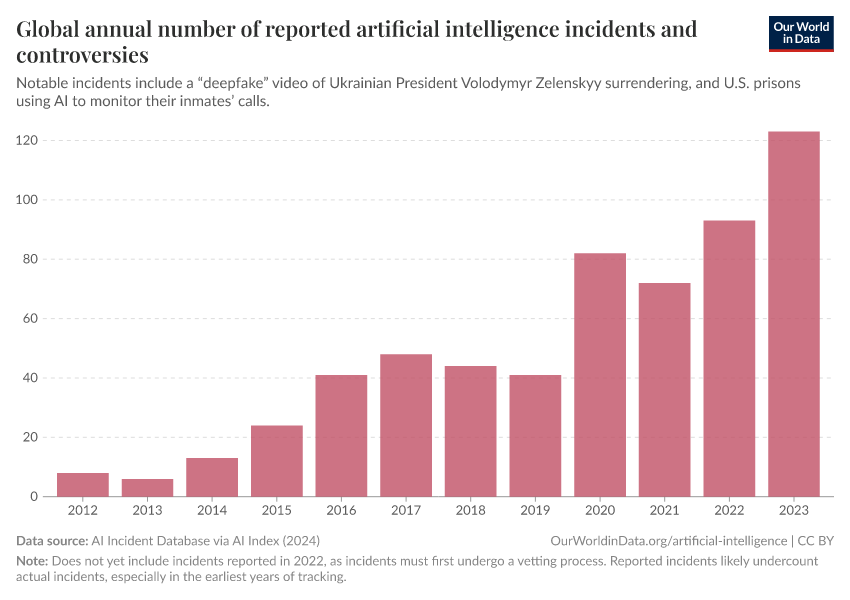Global annual number of reported artificial intelligence incidents and controversies

What you should know about this indicator
- The AI Incident Database (AIID) tracks cases of ethical misuse of AI, such as fatal accidents or wrongful arrests caused by AI systems.
- It relies on public media reports, so the actual number of incidents is likely underreported.
- In 2024, there was active discussion around how to define and track “serious” incidents, but no agreed standard has emerged.
- These conversations highlight the need for better reporting to more accurately document AI-related risks and their consequences.
- The number of AI incidents is continuously updated, including for past years, so the numbers reported here may differ from the latest figures on the AI Incident Database.
What you should know about this indicator
- The AI Incident Database (AIID) tracks cases of ethical misuse of AI, such as fatal accidents or wrongful arrests caused by AI systems.
- It relies on public media reports, so the actual number of incidents is likely underreported.
- In 2024, there was active discussion around how to define and track “serious” incidents, but no agreed standard has emerged.
- These conversations highlight the need for better reporting to more accurately document AI-related risks and their consequences.
- The number of AI incidents is continuously updated, including for past years, so the numbers reported here may differ from the latest figures on the AI Incident Database.
Sources and processing
This data is based on the following sources
How we process data at Our World in Data
All data and visualizations on Our World in Data rely on data sourced from one or several original data providers. Preparing this original data involves several processing steps. Depending on the data, this can include standardizing country names and world region definitions, converting units, calculating derived indicators such as per capita measures, as well as adding or adapting metadata such as the name or the description given to an indicator.
At the link below you can find a detailed description of the structure of our data pipeline, including links to all the code used to prepare data across Our World in Data.
Reuse this work
- All data produced by third-party providers and made available by Our World in Data are subject to the license terms from the original providers. Our work would not be possible without the data providers we rely on, so we ask you to always cite them appropriately (see below). This is crucial to allow data providers to continue doing their work, enhancing, maintaining and updating valuable data.
- All data, visualizations, and code produced by Our World in Data are completely open access under the Creative Commons BY license. You have the permission to use, distribute, and reproduce these in any medium, provided the source and authors are credited.
Citations
How to cite this page
To cite this page overall, including any descriptions, FAQs or explanations of the data authored by Our World in Data, please use the following citation:
“Data Page: Global annual number of reported artificial intelligence incidents and controversies”, part of the following publication: Charlie Giattino, Edouard Mathieu, Veronika Samborska, and Max Roser (2023) - “Artificial Intelligence”. Data adapted from AI Incident Database via AI Index. Retrieved from https://archive.ourworldindata.org/20250912-100322/grapher/annual-reported-ai-incidents-controversies.html [online resource] (archived on September 12, 2025).How to cite this data
In-line citationIf you have limited space (e.g. in data visualizations), you can use this abbreviated in-line citation:
AI Incident Database via AI Index (2025) – with minor processing by Our World in DataFull citation
AI Incident Database via AI Index (2025) – with minor processing by Our World in Data. “Global annual number of reported artificial intelligence incidents and controversies” [dataset]. AI Incident Database via AI Index, “AI Index Report” [original data]. Retrieved January 7, 2026 from https://archive.ourworldindata.org/20250912-100322/grapher/annual-reported-ai-incidents-controversies.html (archived on September 12, 2025).